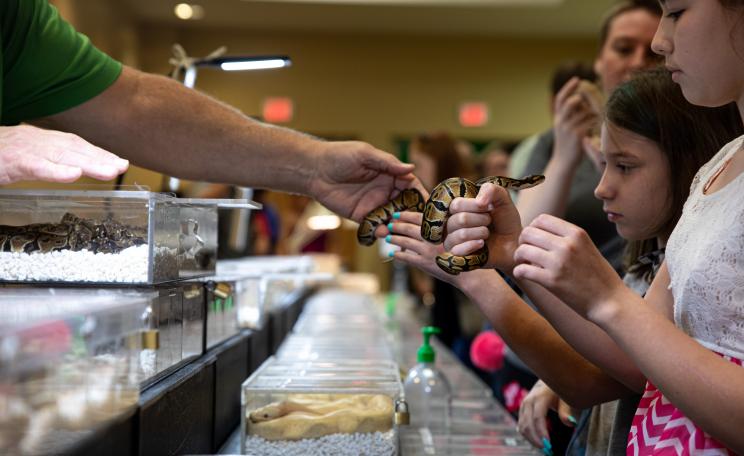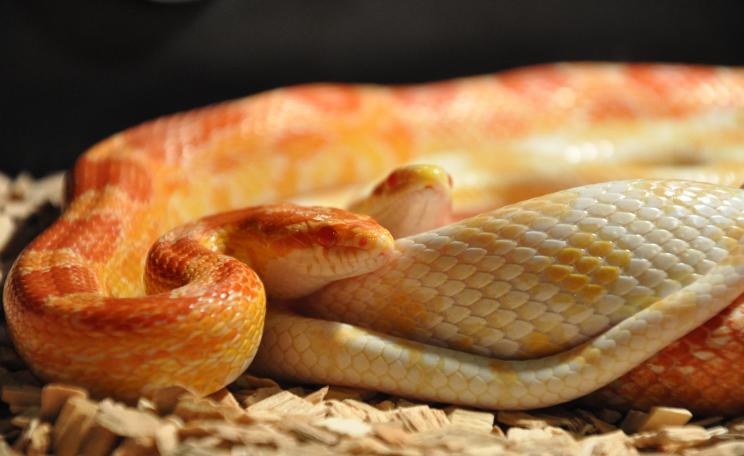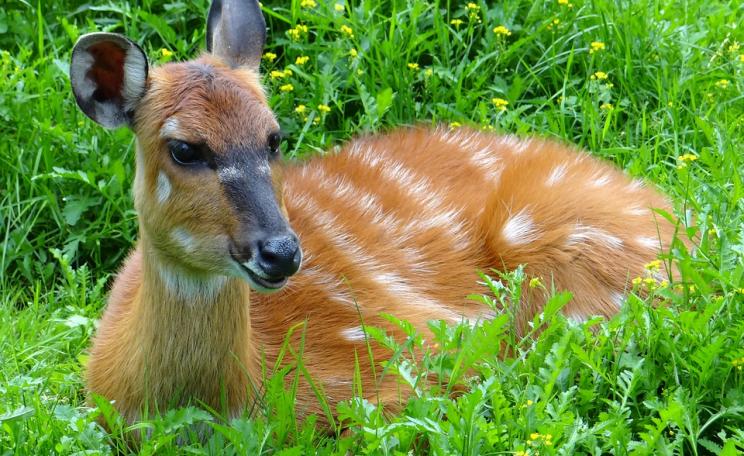Die-off between pet retailer and the home is 81% in a year. The aquarium and reptile industry manifests nearly the same lethality as a slaughterhouse.
For three decades I have worked as a scientist traversing swamps, deserts and forests tracking wildlife hunters as they scour to catch diverse animals for their sacks and boxes. From this moment on, the meter of destruction is already running.
Next, the hunters' swag is readied for a new and commonly shortened life in captivity as part of the growing international market for unusual pets.
Unfortunately, despite shuffling tons of trade permits - many of which can be obtained illegally - few, if any, civil servants, CITES (the Convention on International Trade in Endangered Species of Wild Fauna and Flora) managers or other so-called 'competent authorities' ever physically enter the hard end of the wildlife trade to witness, let alone control, the destruction.
CITES aims to " ... ensure that international trade in endangered species of plants and animals is sustainable." Not only are CITES' aims and achievements somewhat fanciful, but in my experience CITES is often a mere tool for wildlife traders.
Investigate the sources of trade and you will find no controllers, no scientific observers, just exploiters. Anyway, 25% of trade is thought illegal - hardly well under control. Safe 'sustainable' trade is mostly a myth.
Lengthy scientific articles now regularly chronicle the harm inherent to trading wild animals as pets. Just one review this year published in the prestigious journal Conservation Biology concluded:
"International trade in exotic pets is an important and increasing driver of biodiversity loss and often compromises the standards required for good animal welfare; one-fifth of recent wildlife trade reports were driven by demand for pets or animals for use in entertainment; unsustainable harvest of wild animals for the pet trade has already led to population decline and collapse for many species; animal welfare is compromised to some extent at all stages of the exotic pet trade; legality of trade does not guarantee its sustainability; many of the species traded as pets are threatened."
Trade thrives, controls fail.
Poor welfare worsens conservation and ecological threats
Little, if anything, that happens in the exotic pet industry is irrelevant to ecology. For instance, poor (more accurately disastrous) animal welfare affects species conservation and thence ecology because high mortality rates prompt raised compensatory collection and repeat purchases - expensive vivariums need occupants!
According to WWF and an article in The Ecologist, mortality for wild-caught marine fish is approximately 80% pre-sale. Mortality rates on pet fish 'farms' are unclear, but the end result is shocking anyway.
Die-off between pet retailer and the home is 81% in a year. The aquarium and reptile industry manifests nearly the same lethality as a slaughterhouse.
The UK alone imports around 40 million pet fish annually (marine and freshwater) and almost all die prematurely within a year. Reptile trading is another example where destructive collection, breeding and storage lead to an industry-standard presale mortality of 70% within just six.
Die-off between pet retailer and the home is 81% in a year. The aquarium and reptile industry manifests nearly the same lethality as a slaughterhouse.
Survivors are often troublesome to their keepers and released into the local habitat where they may become invasive. At least 51 types of released reptile and amphibian live wild around London alone. Controlling European invasives costs over €12.5 billion annually and the bill is rising fast.
Every imported or released exotic animal is arguably a Trojan horse harbouring a potential suite of novel pathogens that could impact on human health or agricultural livestock.
At least 70 pet-linked human diseases exist as well as a growing raft of threats to industry such as avian influenza to poultry and the degenerative illness 'heartwater' - which could rapidly wipe out cattle farming.
Indigenous wildlife is not immune to introduced disease, as demonstrated by the chytridiomycosis pandemic linked to released pets, which is rampaging through wild amphibian populations.
The irony!
Make no mistake, the international pet trade involves stealing other ecosystems' wildlife, stuffing it into containers, and shipping it around the world to face a likely stress-laden and foreshortened unnatural life in a small cage in someone's lounge.
One cannot help but wonder how the British or any other nation's public would react to viewing one of their favourite indigenous species - be it barn owl, bank vole, or red squirrel - ripped from our own countryside, bundled into bags, crammed into carriers and sent worldwide where they will unlikely arrive ship-shape.
Fortunately, witnessing such destruction in Britain is improbable, because our own wildlife is very well protected. In the UK, and elsewhere, one must commonly obtain a local authority licence to fish at a river, and caught fish are typically promptly returned to their natural habitat.
The Wildlife and Countryside Act 1981 determines that no British birds can be legally caught and sold or kept as pets, and both UK and European law leaves very little room for any wild animal to be treated as a pet commodity.
Not only does the UK government protect its indigenous wildlife, but it is also opposed even to the concept of capturing and selling it as 'would-be exotic pets' to other countries - it states: "We are not aware that unprotected native wild animals are routinely being captured from the wild and sold abroad as pets and would discourage any such activity."
One cannot, however, ignore the tragic irony that whilst the UK takes such good care of its own house and even opposes the mere principle of siphoning off its wildlife, it continues to be one of the major consumers of other nations' biodiversity and consequently erodes ecosystems worldwide.
Conclusions
Trading in exotic pets is an unethical and archaic concept surviving extinction not by merit but by fortuitous commercial biases inherent to the policies of government departments.
Governments do not entertain guidance on trade policy from drug dealers or people traffickers, yet they accommodate the vested and harmful interests of pet dealers and wildlife traffickers.
In particular, it is the obfuscation, obstruction and incompetence of trade-mollycoddling civil servants that stifles both the solid evidential arguments of the scientific community as well as the sincere efforts of the seemingly increasing number of 'eco-aware' parliamentarians.
The exotic pet industry is a pernicious force incompatible with good ecological, animal welfare and public health practices. It hides in plain sight rooted behind the sanitized façade of pet stores and the front doors of private homes, quietly facilitated by trade-permissive legislation.
Long overdue is the need to haul this industry's modern-day dark-age habits to face the cleansing light of scientific scrutiny, neo-political good will, and common sense morals.
Evidential and ethical arguments overwhelmingly justify a complete ban on trading exotic animals as pets. Already available, however, are so-named 'positive lists' - which turn the historical 'free trade' concept around and stipulate 'no trade until proven safe'.
This approach offers a pro-active and not reactive opportunity to favour wildlife over the deepening pockets of pet peddlers. But so long as the exotic pet trade continues, its maleficence will persist to the detriment of animals, humans and the world in which we live.
Clifford Warwick PGDipMedSci CBiol CSci EurProBiol FOCAE FSB is a Consultant Biologist & Medical Scientist.
For more information please contact the Animal Protection Agency.
Sources with links
[1] http://onlinelibrary.wiley.com/doi/10.1111/cosbi.12240/abstract
Bush, ER., Baker, S.E. and Macdonald, D.W. (2013) Global Trade in Exotic Pets 2006-2012. Conservation Biology, Volume 28, No. 3, 663-676 (Nijman & Shepherd 2009; Lyons & Natusch 2011).
[2] http://news.mongabay.com/2013/1022-millar-aquarium-trade-deaths.html
98% of marine fish headed for the aquarium trade die within a year in the Philippines.
[3] /News/news_analysis/2523460/the_dark_side_of_hawaiis_aquarium_trade.html
The dark side of Hawaii's aquarium trade.
[4] http://www.tandfonline.com/doi/abs/10.1080/10888705.2014.918511#.VFu43C…
Ashley, S., Brown, S., Ledford, J., Martin, J., Nash, A E., Terry, A., Tristan, T. & Warwick, C. (2014) Morbidity and mortality of invertebrates, amphibians, reptiles and mammals at a major exotic companion animal wholesaler. Journal of Applied Animal Welfare Science, 17:1-14. DOI:10.1080/10888705.2014.918511.
[5] http://www.cieh.org/jehr/default.aspx?id=41594
Warwick, C., Arena, P.C., Steedman, C. and Jessop, M. (2012) A review of captive exotic animal-linked zoonoses. Journal of Environmental Health Research, 12:9-24
[6] https://www.savethefrogs.com/threats/frog-legs/images/Schloegel-2009-US-Markets.pdf
Magnitude of the US trade in amphibians and presence of Batrachochytrium dendrobatidis and ranavirus infection in imported North American bullfrogs (Rana catesbeiana) Schloegel, L.M., Picco, A.M., Marm Kilpatrick, A., Davies, A.J., Hyatt, A.D, Daszak, P. Biological Conservation 142 (2009) 1420-1426.
Sources without links
Langton, T. E. S., Atkins, W., & Herbert, C. (2011). On the distribution, ecology and management of non-native reptiles and amphibians in the London area. Part 1. Distribution and predator/prey impacts. The London Naturalist, 90, 83-156.
Shine, C., Kettunen, M., Genovesi, P., Essl, F., Gollasch, S., Rabitsch, W., ten Brink, P. (2010). Assessment to support continued development of the EU strategy to combat invasive alien species. Final Report for the European Commission. Brussels, Belgium: Institute for European Environmental Policy.
Toland, E, Warwick, C., & Arena, P.C. (2012) The exotic pet trade: pet hate. The Biologist 59(3);14-18.







